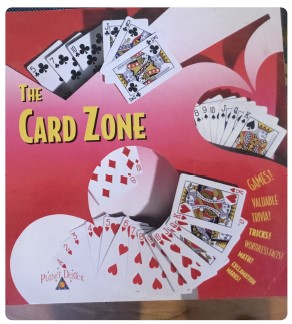Holiday Tidy Up
It has been two years since we packed up our Queensland house and moved to SA and there are still boxes in storage. SO much to do … holidays seem like a good time, so I pestered Johnny and he has built even more bookshelves to store my treasures.
Get this – I now have all of my maths picture books in one place. Hooray!
I have plans (don’t tell Johnny) as there are gaps so I can still collect more books. My big dilemma really is should I keep them all or sift through and get rid of some. Take this one for instance, published in 1995, no longer in print and very dated.

We used to play some of the games in this book with our twins when they were about 11 years old. Should I ditch it?
As I flicked through, I came to a multiplication game and thought: “What a good way to develop memory with multiplication facts.”
This game would work well with the ideas presented in Building Multiplicative Strategies – Number Talk.
Simply put each suit is given a value that is used to multiply the card’s face value. For example, let’s give the suits these values:

If a 2 of clubs is picked up then its product is 20, 2 × 10 = 20.
The aim of the game is to collect pairs of cards that have the same product. The player with most pairs at the end of the game is the winner.
Differentiation
You can choose the value for the suits to match your learners needs. You can also remove picture cards and cards with values of more than 6 if you want to limit the range.
Alternatively, you can offer a times table chart (like the × strategy mat….) or a calculator if you want to.
I am pretty sure it was De Bono who said a lot of stuff gets into our heads by accident and I am convinced that if you have looked up 6 × 7 on the tables grid a few times there will come a time when that fact just jumps into the head by accident when needed one time and the chart is no longer needed.
Use of tools will also mean that players at different entry points can play together.
Rules
Players are dealt 5 cards.
On their turn they try to make pairs with the same product. Pairs are set aside and replacement cards are taken from the deck, or a player can discard the remaining cards and take 5 new cards.
A player continues till they can no longer make a pair. Play passes to the next player.
Eventually the discard pile can be shuffled and play continues.
So…
Back to the book … my decision is keep the book at least until I have shared a few more gems from it.
If you try the game let us know how it went on our Facebook page.
*Have a great term. I am wondering how to switch my work brain back on.*
PS: You all saw the silly holiday brain mistake I made in my last blog. So sorry! Glad to know you are reading my blog though – thanks!!
